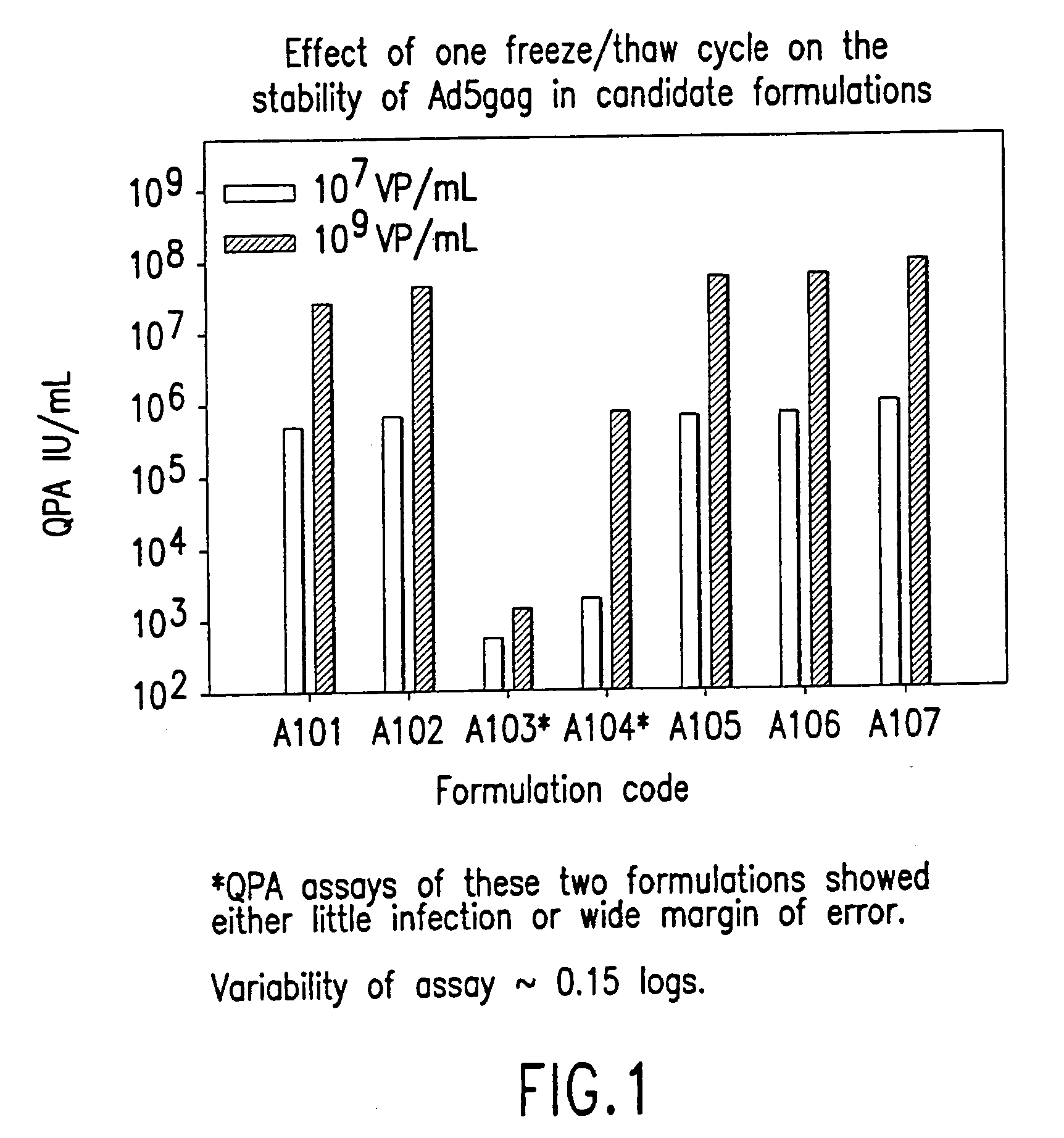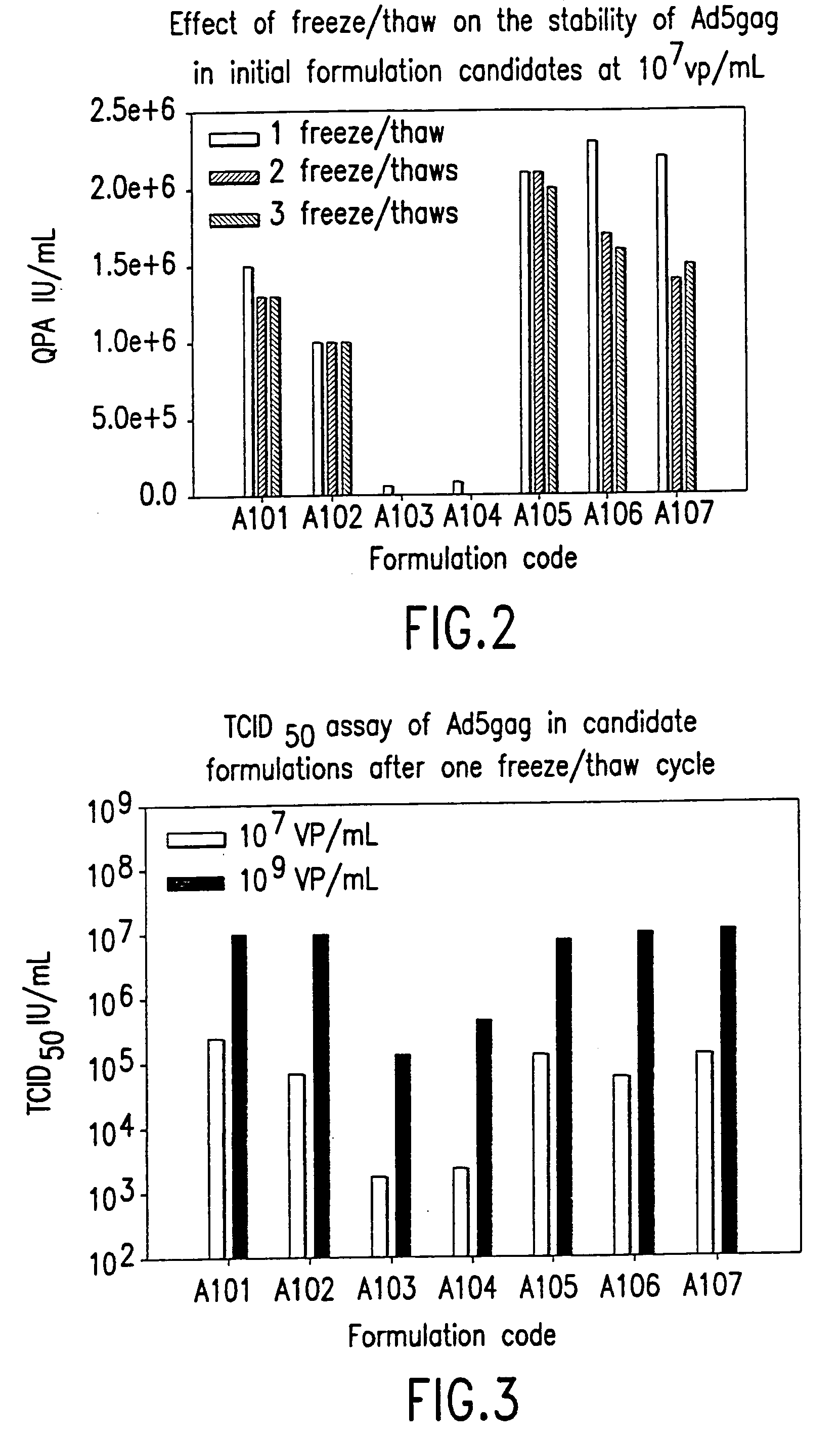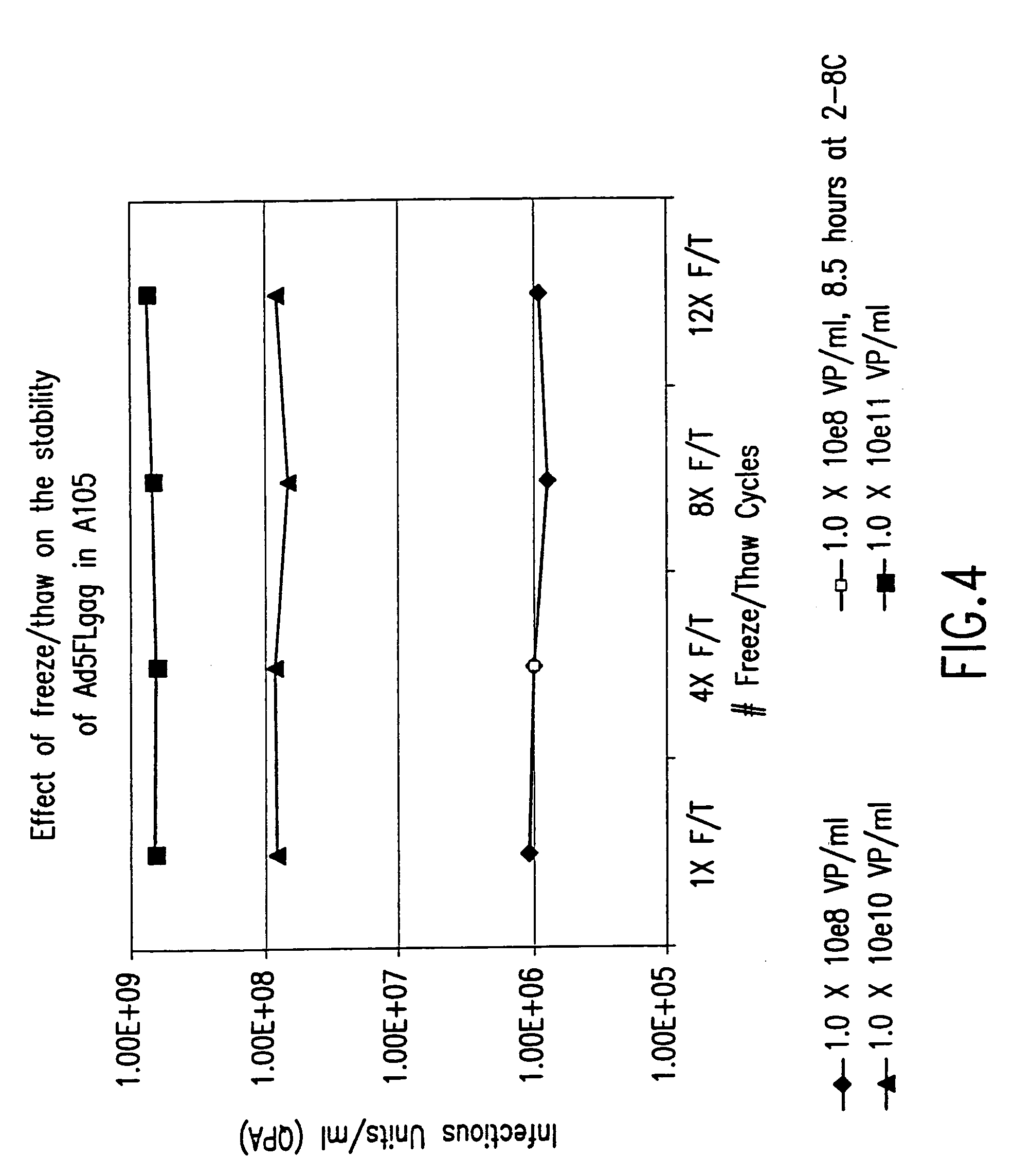Adenovirus formulations
a technology of adenovirus and formulation, which is applied in the field of viral formulations, can solve the problems of little published on the development of stabilization and formulation of adenovirus poor prospects for stable liquid formulation, and unattractive lyophilized formulations for human parenteral administration, etc., to enhance short and long term stability, enhance long term stability, and enhance the stability of virus-containing formulations
- Summary
- Abstract
- Description
- Claims
- Application Information
AI Technical Summary
Benefits of technology
Problems solved by technology
Method used
Image
Examples
example 1
Exemplified Formulation Number and Components
[0109] Formulation numbers represent exemplified formulations which, along with accompanying stability data, support the claims appended hereto.
Form. #DescriptionA10110 mM Tris, 10% glycerol (v / v), 1mM MgCl2, pH 7.5A1026 mM phosphate, 150 mM NaCl, 10%glycerol (v / v), pH 7.2A1036 mM phosphate, 150 mM NaCl, pH 7.2A1045 mM Tris, 150 mM NaCl, 1 mM MgCl2,0.005% PS-80, pH 8.0A1055 mM Tris, 75 mM NaCl, 5% sucrose(w / v), 1 mM MgCl2, 0.005% PS-80, pH 8.0A1065 mM Tris, 14% sucrose (w / v), 1 mMMgCl2, 0.005% PS-80, pH 8.0A1075 mM Tris, 8% sorbitol (w / v), 1 mMMgCl2, 0.005% PS-80, pH 8.0A1085 mM Tris, 75 mM NaCl, 5% sucrose(w / v), 0.005% PS-80, pH 8.0A1095 mM Tris, 75 mM NaCl, 5% sucrose(w / v), 1 mM MgCl2, pH 8.0A1105 mM Tris, 75 mM NaCl, 5% sucrose(w / v), 1 mM MgCl2, 0.02% PS-80, pH 8.0A1115 mM Tris, 75 mM NaCl, 5% sucrose(w / v), 1 mM MgCl2, 0.1% PS-80, pH 8.0A1125 mM Tris, 75 mM NaCl, 5% sucrose(w / v), 1 mM MgCl2, 0.005% PS-80,100 μm DTPA, pH 8.0.A1135 mM...
example 2
Effect of Freeze / Thaw on the Recovery and Stability of Human Adenovirus 5
[0110] The effect of freeze / thaw on the recovery / stability of Ad5gag was examined initially in formulations A101-A107 at both 107 and 109 vp / mL. FIG. 1 shows the effects of one freeze / thaw cycle (from −70° C. to 5° C.) on the recovery / stability of Ad5gag in the initial seven formulations, as measured by the QPA assay. The results indicate that Ad5gag lost significant amounts of infectivity, or was adsorbed to the glass vial, in the two formulations that did not contain a cryoprotectant (A103 and A104). The results also indicated that the infectivity was at the level expected for the Ad5gag concentration in A101, A102, A105-A107, suggesting that there was no significant loss of recovery from the glass vial. The effects of multiple freeze / thaw cycles were also examined. The data in FIG. 2 show the effects of 1 to 3 freeze / thaw cycles on the recovery / stability of Ad5gag in the initial formulations. The results in...
example 3
Evaluation of Human Adenovirus Formulations Based on Short-Term Stability
[0114] One of the initial stability studies was designed to test the short-term stability of Ad5gag in the candidate formulations at 2-8° C. Since one of the stability criteria for implementation into a GMP clinical supplies operation was to ensure stability through a filling operation, a short-term study was initiated using Ad5gag at both 107 and 109 vp / mL in 3 mL glass vials, and assaying for infectivity by QPA after 72 hours of storage at 2-8° C. The results in FIG. 6 indicate that Ad5gag in formulation A 102 was significantly less stable than in the other formulations tested. These QPA results were obtained by measuring the log loss in infectivity compared to the −70° C. control.
[0115] The stability of Ad5gag in A102, A105, A106 and A107 was also determined at both 107 and 109 vp / mL by QPA after 6 months of storage at −15° C. The results indicated 50 assays conducted after 6 months of storage at −15° C. (...
PUM
| Property | Measurement | Unit |
|---|---|---|
| temperature | aaaaa | aaaaa |
| temperatures | aaaaa | aaaaa |
| pH | aaaaa | aaaaa |
Abstract
Description
Claims
Application Information
 Login to View More
Login to View More - R&D
- Intellectual Property
- Life Sciences
- Materials
- Tech Scout
- Unparalleled Data Quality
- Higher Quality Content
- 60% Fewer Hallucinations
Browse by: Latest US Patents, China's latest patents, Technical Efficacy Thesaurus, Application Domain, Technology Topic, Popular Technical Reports.
© 2025 PatSnap. All rights reserved.Legal|Privacy policy|Modern Slavery Act Transparency Statement|Sitemap|About US| Contact US: help@patsnap.com



